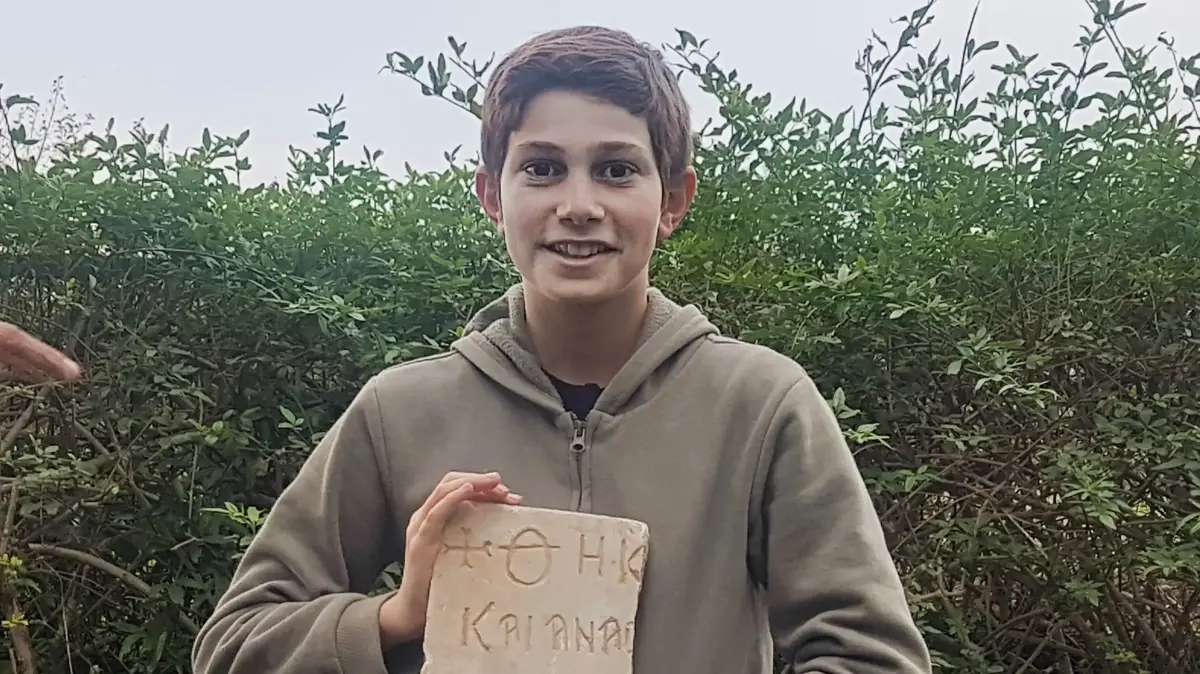He went looking for mushrooms and discovered an ancient marble inscription dating back to 1500 years
13-year-old Meir, from Caesarea, left a week ago with his family to look for mushrooms in his area. Suddenly he recognized a stone slab from the ground. Archaeologists: "This is a fragment of an imported marble tombstone, the quality of which illustrates well the extraordinary wealth of Caesarea's riches some 1500 years ago"
He went looking for mushrooms and discovered an ancient marble inscription dating back to 1500 years
Carm Said, Israel Antiquities Authority13-year-old Meir, a resident of Caesarea, went out a week ago with his father Zohar, his brothers and his cousins to look for mushrooms in his area after the rains. Suddenly, he recognized a stone slab from the ground. He quickly called his father and showed him the intriguing object, which had an inscription in Greek. "I immediately recognized that it was something ancient," Fall says. "At Caesarea Elementary School, I studied archeology, so I can easily identify antiques when I see them."
The excited fall, who understood the importance of reporting, quickly updated the IAA to find the address, and an archaeologist came to collect it for research.
According to archaeologist Dr. Peter Gendelman, a Caesarea researcher at the Israel Antiquities Authority, "this is a burial inscription - a marble plaque with an inscription inscribed in Greek, with a cross on it. On the plaque, which apparently indicated the grave location in the cemetery and the identity of the deceased - or deceased, it is written - "Grave of .... and of Anastasius, or Anastasia .....".
According to Dr. Gendelman, "In ancient times Caesarea was a center of attraction for a strong population. The use of imported marble in order to create the tombstone that was discovered in the fall is indicative of the grave's affluent status, including the customs, beliefs and wealth of the people of Caesarea Byzantine. This inscription joins a large collection of burial inscriptions, previously discovered around ancient Caesarea. "
Good to Know (Promoted Content) Good to Know (Promoted Content)Exclusive offer - Try a free service that will save your life
In collaboration
To the full articleAutumn receives a certificate of recognition from Carm Said for his work and the delivery of the important finds (Photo: Carm Carm Said, Israel Antiquities Authority)
A Greek marble inscription from the Byzantine period in the Caesarea area (Photo: Carm Said, Israel Antiquities Authority, Israel Antiquities Authority)
"I immediately recognized that it was something ancient" (Photo: Carm Said, Israel Antiquities Authority)
A Greek marble inscription from the Byzantine period in the Caesarea area (Photo: Carm Said, Israel Antiquities Authority, Israel Antiquities Authority)
"Rainstorms bring to the surface archaeological finds"
During the Byzantine period, the rich of Caesarea built magnificent mansions in the suburbs of the city. These buildings gave their owners quality of life, so that they enjoyed the rural character of the area on the one hand and the proximity to the heart of the city on the other. To date, sections of five magnificent mansions have been discovered in the area, covering an area of land, known as the Bird Mosaic Building, whose area is estimated to be half an acre. Most of the floors in the complex, which were excavated and partially open to the public today, were made of colored mosaics.
According to Karm Said, Haifa District Archaeologist in the Israel Antiquities Authority, "The recent rainstorms have brought to the ground archeological findings that were buried in the ground. The IAA is pleased and proud in the fall for its good citizenship, and for the actual implementation of the content that he - and his two brothers - learn with us in the classroom. Finding the Address Enriches Archaeological Knowledge and Understanding Ancient Caesarea We Giving a Fall Certificate of Appreciation for His Good Citizenship and Reaching His Class for a Special Lesson to Address It We Call for Citizens to Partner in Conserving the Treasures of the Land - Tell Us If You Have Encountered Archaeological Findings The surface in the rains. "
Thousands of schoolchildren across the country are studying archeology with the Israel Antiquities Authority as part of its landmark policy, which seeks to bring the public closer to it. The curriculum breathes life into cultures and ancient times as part of classroom and field lessons. The lessons combine archeological finds, puzzle pieces, archaeological excavations and tours. The routine breaking activities connect the children and youth in the country to the world of antiquities and those who lived here before them, and tighten the chain of generations. The program operates in schools from all sectors across the country and is tailored to the nature of the areas of activity.

